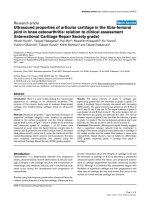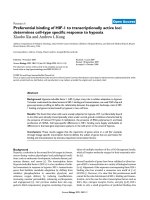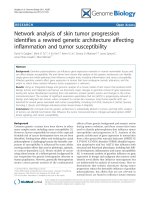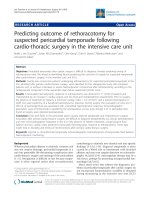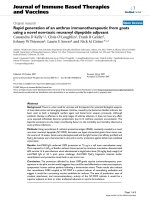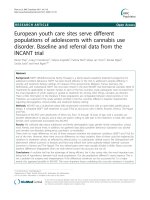Báo cáo y học: "European Society of Intensive Care Medicine 14th Annual Congress, 30 September–3 October 2001, Geneva, Switzerland" docx
Bạn đang xem bản rút gọn của tài liệu. Xem và tải ngay bản đầy đủ của tài liệu tại đây (32 KB, 3 trang )
ESICM = European Society of Intensive Care Medicine; ICU = intensive care unit; NO = nitric oxide.
Critical Care December 2001 Vol 5 No 6 Preiser
The Annual Congress of the European Society of Intensive
Care Medicine (ESICM) gathered 2500 registered partici-
pants, mainly physicians, nurses and physiotherapists working
in the intensive care unit (ICU). This number was slightly lower
than in previous meetings of the ESICM, probably because of
the tragic events in the United States only 3 weeks before.
Nonetheless, most sessions had a large audience, allowing
numerous interactive discussions. Although clinically oriented,
this meeting also offers the opportunity for basic scientists to
present data relevant to the pathophysiology or to new thera-
peutic approaches of common complications occurring in criti-
cally ill patients. Six hundred abstracts were accepted for the
main program, and 28 for the nursing and physiotherapy ses-
sions. The 3-day program included 39 thematic sessions, 72
sessions dedicated to oral or poster presentations of
abstracts, and nine educational sessions. The major sponsors
(pharmaceutical and technological companies) organized
seven additional sessions during lunchtimes. The physiother-
apy and nursing section of the ESICM organized nine thematic
sessions and four oral or poster sessions.
The main topics covered included acute respiratory failure,
ethics, sepsis, cardiovascular dysfunction, nutrition, metab-
olism, renal support therapies, and the management of
neurotrauma, presented as well-balanced mixtures of clini-
cal and experimental findings. The results of experimental
data on the effects of several new compounds, mainly used
in the fields of sepsis and acute lung injury, were pre-
sented. A European Sepsis Network was implemented
during the meeting.
New technological approaches, including recently devel-
oped monitoring and therapeutic tools, have been assessed
in patients and were reported. In addition, a growing
numbers of abstracts were dedicated to typically clinical
topics, including ethics, outcome/quality of life, costs of ICU
care, sedation, and new technologies. For instance, the
results of the ETHICUS audit, a European survey of the
current practice of end-of-life decisions, were presented for
the first time.
Meeting report
European Society of Intensive Care Medicine 14th Annual
Congress, 30 September–3 October 2001, Geneva, Switzerland
Jean-Charles Preiser
Department of Critical Care, Centre Hospitalier Notre-Dame Reine Fabiola, Charleroi, Belgium
Correspondence: Jean-Charles Preiser,
Published online: 1 November 2001
Critical Care 2001, 5:326-328
© 2001 Current Drugs Ltd (Print ISSN 1364-8535; Online ISSN 1466-609X)
Reproduced with permission and modifications from the Investigational Drugs Database ()
Abstract
The European Society of Intensive Care Medicine Annual Congress offers the opportunity for basic
scientists and clinicians to share recent findings. Apart from the large number of free communications,
several sessions of the congress were dedicated to state-of-the-art tutorials given by established
speakers. The areas of interest of the attendees were widely distributed as usual, a reflection of the large
array of so-called ‘critical illnesses’. The results of clinical trials and experimental findings using recently
developed drugs were presented, essentially in the fields of inflammation, sepsis, and acute lung injury.
The benefits of several new compounds observed experimentally need to be confirmed clinically. The
European Society of Intensive Care Medicine Congress is well established as a unique opportunity to
implement and to promote a collaboration between European basic scientists and clinicians.
Keywords acute lung injury, ethics, multi-resistant microorganisms, sepsis, vasopressin
Available online />research
commentary review
reports
meeting abstracts
Sepsis
Nitric oxide pathway inhibitors
The role of nitric oxide (NO) in the cellular alterations of
septic shock is intensively investigated. For instance,
Dr Singer et al., from University College of London, UK,
demonstrated a close correlation between circulating levels
of the stable byproducts of NO, the severity of septic shock,
and the activity of the mitochondrial complex I and ATP levels
measured in muscle biopsies of septic patients. Comparing
1400W and GW273629 (two selective inhibitors of the
inducible isoform of the NO synthase enzyme) with a NO
scavenger (carboxy-PTIO), with a guanylate cyclase inhibitor
(ODQ), and with L-NAME, a non-selective NO synthase
inhibitor, Singer et al. reported that the contractile hypo-
responsiveness of isolated rat arterial rings to phenylephrine
was reversed by all agents but the NO scavenger. In human
arteries exposed to interleukin-1 and endotoxin, 1400W but
not L-NAME administration reversed the hyporesponsiveness
to phenylephrine. Dr Siegemund et al., from the University of
Basel, Switzerland, also found that 1400W inhibitor restored
gut perfusion, decreased functional oxygen shunting, and
increased coronary blood flow and myocardial microvascular
oxygenation in a porcine model of endotoxemia. Likewise, in
another pig model of endotoxemia, Dr Radermacher et al., of
the University of Ulm, Germany, found an improved gut perfu-
sion following administration of 1400W.
The toxicity of NO probably involves the activation of poly-
(ADP-ribose)-synthetase enzyme by peroxynitrite. The effects
of a novel poly-(ADP-ribose)-synthetase inhibitor (PJ34) were
assessed in a rabbit model of endotoxic shock in the labora-
tory of Dr Vincent of the Free University of Brussels, Belgium.
Significant improvements in hemodynamic parameters and
serum gut lactate concentrations were reported, suggesting a
protective role of this agent in the cellular alterations of endo-
toxic shock. The effects of a poly-(ADP-ribose)-polymerase (3-
aminobenzamide) were evaluated in a rat model of myocardial
ischemia by Dr Liaudet et al. from CHUV University Hospital,
Lausanne, Switzerland. Promisingly, the size of the infarcted
area was reduced and left ventricular function was preserved
following the administration of 3-aminobenzamide.
The cardiovascular effects of a continuous infusion of methyl-
ene blue, a guanylate cyclase inhibitor, during septic shock in
patients was described by Dr Kirov of Northern State Medical
University, Arkhangelsk, Russia. The already described posi-
tive inotropic and vasoconstrictive effects of this agent
appeared to be sustained, and appeared not to be associ-
ated with significant side effects.
Antibiotics
The growing emergence of multi-resistant microorganisms was
confirmed in several countries, although the appropriateness of
the initial antibiotherapy administered to septic patients was
confirmed in several studies presented during this ESICM
meeting. However, changes in antibiotic policies are probably
mandatory to reduce the occurrence of multi-resistant bacteria.
A prospective observational study, presented by Dr Lorente of
the University Hospital of Las Canarias, Spain, evaluated the
effects of a patient-to-patient rotation policy. Compared with
the data from the European Prevalence of Infection in Intensive
Care study, the incidence of infections – related to multi-resis-
tant Gram-negative bacteria and fungi infections – was lower
after implementing the rotation policy. The rate of antibiotic
resistance was also lower.
Dr Kollef et al. of Washington University School of Medicine,
Missouri, USA, found that the topical oral administration of
Iseganan, a synthetic analog of the protegrin antimicrobial
peptides, decreased the oral microbial burden of intubated
patients. Although promising, this approach warrants confir-
mation in large-scale studies.
Vasopressin and related analogs
Several teams investigated the effects of vasopressin and
related analogs, both experimentally and clinically. In non-
septic rabbits, Dr Payen et al. of McGill University, Montreal,
Canada, studied the effects of arginine vasopressin on arterial
pressure and renal hemodynamics. Arginine vasopressin was
found to influence the systolic renal blood flow more than the
diastolic renal blood flow, and to influence medullar more than
the cortical flow. In an ovine model of endotoxic shock, Dr
Bone et al. from the University of Munster, Germany, carefully
studied the dose–effect relationships of vasopressin and terli-
pressin (a long-acting vasopressin analog) and confirmed the
potent vasoconstrictive effects of these compounds. In a
sheep model of cecal ligation and puncture, Dr Vincent et al.
of the Free University of Brussels, Belgium, compared vaso-
pressin with norepinephrine. Administration of vasopressin
was associated with an improvement in tissue oxygenation,
assessed by blood lactate concentrations and PCO
2
gap. In
contrast, Dr Chioléro, from CHUV University Hospital, Lau-
sanne, Switzerland, presented clinical data recorded in
patients with vasoplegia (septic shock or postcardiopulmonary
bypass). Along with a large increase in vascular resistance, an
increase in PCO
2
gap was reported. Hence, in clinical condi-
tions, the effects of vasopressin on gastrointestinal perfusion
needs to be further clarified. In another clinical study – per-
formed by Dr Dunser of Leopold Franzens University, Inns-
bruck, Austria – the administration of arginine vasopressin was
devoid of significant hemodynamic side effects in patients with
postcardiotomy distributive shock. In another clinical study
performed in patients with severe septic shock by Dr Singer et
al. from University College of London, UK, a single bolus of
terlipressin was followed by a long-lasting vasoconstriction
that allowed a reduction of the dose of norepinephrine. The
issues of safety and clinical usefulness of vasopressin and
analogs require confirmation in larger clinical studies.
Others
Dr Schmidt et al. from the University of Heidelberg, Germany,
presented compelling evidence for the involvement of a sero-
Critical Care December 2001 Vol 5 No 6 Preiser
tonin-mediated pathway in leukocyte-independent plasma
extravasation, in keeping with previous findings of this labora-
tory. The new experiments demonstrated that methysergide
(a mixed 5-HT1/2 receptor antagonist) was as efficient as
cinanserin (a selective 5-HT2 receptor antagonist) and
ketanserin (a 5-HT2A receptor antagonist) in treating
microvascular hyperpermeability, assessed by intravital gut
microscopy in endotoxemic rats. The authors suggest the
effects of serotonin are mainly mediated via the activation of
5-HT2A receptors.
Another recently described pathophysiological mechanism of
intestinal ischemia-induced shock involves the translocation
of pancreatic proteases across the injured gut barrier.
Accordingly, Dr Fitzal et al. of the Ludwig Boltzmann Institute,
Vienna, Austria, reported, in a model of gut ischemia/reperfu-
sion, that intestinal lavage with gabexate mesilate (a serine
protease inhibitor) decreased leukocyte activation and
decreased local and remote organ damage.
Dr Radermacher et al. of the University of Ulm, Germany,
used ATP-MgCl
2
in a porcine hyperdynamic model of endo-
toxemia. This agent had already been found to decrease
cellular damage in several models of low cardiac output. Con-
sistently, the data presented during this meeting confirmed a
decrease in the PCO
2
gap without a concomitant change in
mucosal microcirculation.
Dr Petillot et al. of the University of Lille, France, assessed the
efficacy of the caspase inhibitor, zVAD.fmk – which was pre-
viously reported to attenuate septic myocardial dysfunction –
in reducing apoptosis. Indeed, the uptake of iodinated
Annexin V by rat myocardium was reduced following treat-
ment with the caspase inhibitor, although it was not restored
to normal values recorded in non-septic hearts.
Dr Vincent of the Free University of Brussels, Belgium, pre-
sented new data from the PROWESS study; it demon-
strated an improvement in survival of patients with severe
sepsis following the administration of Activated Protein C
(drotrecogin alfa [activated]). In a subgroup analysis after
stratification according to the severity of disease, the reduc-
tion in mortality was significant in all groups except those in
the first APACHE II quartile. However, given that this quartile
had a low disease severity – as defined by clinical and bio-
chemical measures – as well as a low rate of adverse events
and complications, Dr Vincent concluded the drug’s effect in
this quartile was consistent with that observed in the overall
trial population.
Acute lung injury
Inhalation of a nebulized water-soluble NO donor (DS1) was
assessed in a sheep model of endotoxin-induced acute lung
injury in the laboratory of Dr Bjertnaes of the University of
Tromso, Norway. The major effects were decreases in pul-
monary hypertension, vascular resistance and microvascular
pressure, and extravascular lung water, and a progressive
improvement in arterial oxygenation.
Dr Koh of the University of Ulsan, Seoul, Korea, and Dr Xiao-
Li, Fujian of the Medical University, FuZhou, China, explored
several putative mechanisms of endotoxin-induced lung injury
in rats. The data presented during the congress indicate that
pretreatment with itraconazole, anisodamine, and ramipril
attenuated the severity of endotoxin-induced pulmonary
inflammatory response, namely via a decrease in the produc-
tion of interleukin-1.
Ethics
The results of the ETHICUS study, a European survey
designed to describe the current practice of end-of-life pro-
cedures, were presented. Thirty-seven centers from 17 coun-
tries screened the outcome of ICU patients during 18
months. A total of 4280 deaths out of 31,417 screened
patients occurred during the ICU stay or up to 2 months after
discharge. The patients were categorized as ‘failed cardio-
pulmonary resuscitation’ (approximately 20%), ‘brain death’
(approximately 8%) or ‘end-of-life decision (withholding, with-
drawing, or shortening of the dying process)’ (approximately
72%). Interestingly, the doctor’s religion contributes to the
clinical decision-making process. For instance, withholding
treatment was almost four times more common among
Protestant physicians than Greek Orthodox physicians. The
physicians were aware of the patient’s wishes in only 20% of
the cases, and the thoughts of the families about end-of-life
procedures were ascertained in about 50%, although the
decision was communicated in 90%. The end-of-life decision
was written in two-thirds of the cases. Large variations in the
procedure of end-of-life decisions and in the communication
of decisions to the patient’s relatives and to ICU staff also
exist between the north and the south of Europe.
Summary
This ESICM Congress gathered a wide array of European
ICU professionals, and successfully covered the hot topics
related to the care of critically ill patients. Most novel data
related to new pharmacological tools were assessed in the
fields of the so-called ‘malignant inflammation’ and provided
several promising approaches that require clinical evaluation.
Interestingly, the issues of ethics and outcome are gaining
considerable interest, as ICU practitioners clearly need to
compare their own practices. Similarly, the need to share the
local policies of antibiotherapy should be encouraged in
order to face the persistent emergence of multi-resistant
microorganisms, a major public health problem that is particu-
larly challenging in most European ICUs.
Competing interests
None declared.

